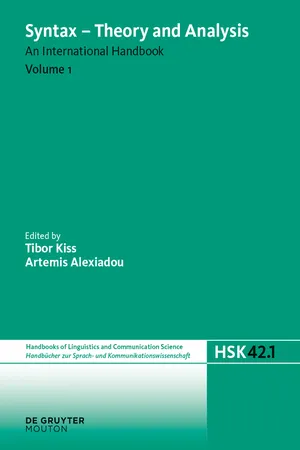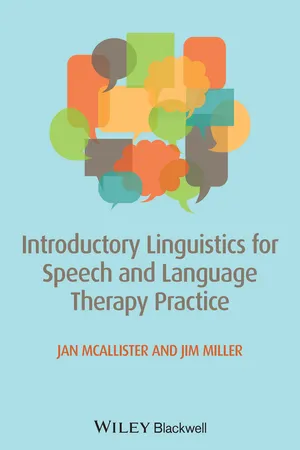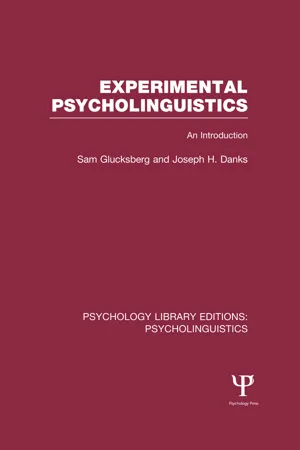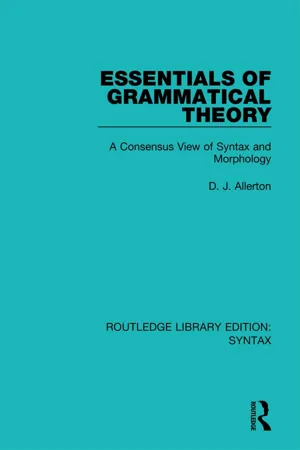Languages & Linguistics
Syntax
Syntax refers to the rules and principles that govern sentence structure in a language. It encompasses the arrangement of words, phrases, and clauses to form grammatically correct and meaningful sentences. Syntax also involves the study of how different elements in a sentence relate to each other, including word order, sentence types, and grammatical functions.
Written by Perlego with AI-assistance
Related key terms
12 Key excerpts on "Syntax"
- eBook - ePub
- Bruce M. Rowe, Diane P. Levine(Authors)
- 2022(Publication Date)
- Routledge(Publisher)
CHAPTER 5 Syntax: the larger patterns of languageDOI: 10.4324/9781003268369-5LEARNING OBJECTIVES- Define the term Syntax.
- Analyze the statement “Syntax is basically subconscious knowledge.”
- List the names of the units that are larger than words and that make up sentences.
- List the names of different sentence types based on the types of clauses that construct each sentence type.
- Explain what types of sentences there are based on their meaning, function, or voice.
- Language is rule-governed. Discuss some of the general syntactic rules that a native speaker of a language knows.
- Word order is very important in some languages and less important in others. Explain why this is so.
- Report on who Noam Chomsky is and include what some of his contributions to linguistics are.
- Explain what phrase structure rules and phrase markers are.
- Discuss what is meant by saying that language has a hierarchical structure.
- Explain what is meant by the recursive property of language.
- Define transformational rules. List and explain the four basic types of transformations.
- Define grammaticality judgment.
- List the three types of ambiguity discussed in this chapter and provide at least one example of each.
- Explain how ambiguous and synonymous utterances can be seen in terms of deep and surface structure.
The word Syntax is derived from the Greek elements syn, meaning together, and tax, which means arranging. Syntax is a level of grammar that specifically refers to the arrangement of words and morphemes (the lexicon) in the construction of structures such as phrases, clauses, and sentences. Syntax also deals with how these combined structures interface with external behaviors such as speech (sound), sign language (gestures), and writing to make the combined structures useful in communication. Lexical categories discussed in Chapter 4 - eBook - ePub
- Martyn Long, Clare Wood, Karen Littleton, Terri Passenger, Kieron Sheehy(Authors)
- 2010(Publication Date)
- Routledge(Publisher)
Chapter 10 .Syntax and grammarThe general study of word order is known as ‘Syntax’. Grammar technically refers to any form of rule-based system in language and applies to all levels of analysis, including the regularities in sounds, words, text and meaning. Traditional grammar is a particular form that is derived from classical studies of Greek and Latin. It involves analysing words into the main classes of nouns, verbs, prepositions, articles, pronouns, conjunctions, adjectives and adverbs. Rules then govern the way in which these are modified and form phrases and clauses, how these can be combined to form sentences, and the general organisation of bodies of text.The main purpose of language is communication: the transfer of meaning from one person to another to achieve practical purposes. Achieving communication must involve some structural system that is able to change thoughts into a form that can be spoken, and a reverse system of altering what has been heard, into its underlying meaning. Chomsky (1965) developed a well-known system of linguistic rules called a ‘generative grammar’, which governs how this can be done, involving the analysis of sentences into phrases and word classes. According to this approach, the sentence ‘The boy kicks the ball’ is a single clause with the basic underlying structure of somebody (the boy) carrying out an action, which is to kick the ball. This is analysed as:A system of rules applied in this way can account for our ability to produce grammatical sequences, and will rule out a sentence such as ‘the boy ball the kicks’, which is ungrammatical in English. Chomsky also believed that it is necessary for us to carry out processes called ‘transformations’, to simplify analyses and to relate together sentences with similar meanings but different structures. For example, the sentence, ‘The ball is kicked by the boy’ has the same basic meaning as the sentence above but has a very different and more complex phrase-structure analysis. This analysis is simplified by applying a transformational rule, which converts between the active sentence and its passive form. This particular rule is carried out by taking the second noun phrase, adding an auxiliary verb ‘is’, modifying the form of the verb, then adding ‘by’, followed by the first noun phrase. - eBook - ePub
- Maggie Tallerman(Author)
- 2019(Publication Date)
- Routledge(Publisher)
1 What is Syntax? 1.1 SOME CONCEPTS AND MISCONCEPTIONS 1.1.1 What is the study of Syntax about? This book is about the property of human language known as Syntax. ‘Syntax’ means ‘sentence construction’: how words group together to make phrases and sentences. Some people also use the term GRAMMAR to mean the same as Syntax, although most linguists follow the more recent practice whereby the grammar of a language includes all of its organizing principles: information about the sound system, about the form of words, how we adjust language according to context, and so on; Syntax is only one part of this grammar. The term ‘Syntax’ is also used to mean the study of the syntactic properties of languages. In this sense it’s used in the same way as we use ‘stylistics’ to mean the study of literary style. We’re going to be studying how languages organize their Syntax, so the scope of our study includes the classification of words, the order of words in phrases and sentences, the structure of phrases and sentences, and the different sentence constructions that languages use. We’ll be looking at examples of sentence structure from many different languages in this book, some related to English and others not. All languages have Syntax, though that Syntax may look radically different from that of English. My aim is to help you understand the way Syntax works in languages, and to introduce the most important syntactic concepts and technical terms which you’ll need in order to see how Syntax works in the world’s languages. We’ll encounter many grammatical terms, including ‘noun’, ‘verb’, ‘preposition’, ‘relative clause’, ‘subject’, ‘nominative’, ‘agreement’ and ‘passive’. I don’t expect you to know the meanings of any of these in advance - eBook - ePub
- Tibor Kiss, Artemis Alexiadou, Tibor Kiss, Artemis Alexiadou(Authors)
- 2015(Publication Date)
- De Gruyter Mouton(Publisher)
I. Introduction: Syntax in Linguistics
1. Syntax – The State of a Controversial Art
Abstract
This article provides a broad introduction to Syntax, as it is conceived in this handbook. We will present a number of assumptions that have been considered to constitute common ground for all syntacticians. But they are as fundamental as they are controversial for syntactic theory and analysis. In fact, approaches to syntactic analysis as well as syntactic theories quite often take controversial positions, leading to the apparent conclusion that syntactic research is fractured. It is not our goal to offer a band-aid to patch up what better should be kept separate. Our conclusion is that many issues might indeed be controversial within syntactic research but that such controversy should be seen as the driving force behind progress in Syntax.1. Introduction
Perhaps the simplest way to approach Syntax is to define it as the linguistic component that relates sound and meaning, and thus fulfils this crucial task in mapping the two intelligible sides of the Saussurean sign. Syntax must thus be able to break up the continuous flow of sound signals into elementary tokens, must be able to provide a structure for the tokens, and enable the semantic component to access the tokens − and the larger parts made of them in order to account for the interpretation of complex units. It goes without saying that the same story could be told if we started with the interpretational component, letting Syntax map meaning to sound.A grammar consists of a complex formal unit that requires analysis, a rule system relating atomic and complex units to the complex formal unit under analysis, and a characterization of the atomic or elementary elements, and how they relate to the rule system. Typically, the sentence (S) is the formal unit that requires analysis, there are all kinds of rule systems resulting in a sentence, and the lexical units are taken to be the atomic elements, which are assigned appropriate categories so that the rule system can make use of them. This characterization seems to be uncontroversial, and it owns its - eBook - ePub
Speech to Print
Language Essentials for Teachers
- Louisa Cook Moats(Author)
- 2020(Publication Date)
- Brookes Publishing(Publisher)
syntactic categories, allows speakers of a language to communicate. Linguists are interested in describing the nature of this underlying syntactic rule system and how people use it.Academic linguists devise theories of syntactic rule systems to explain and portray actual patterns of speech (descriptive grammar), but they are not necessarily motivated to uphold a particular standard of grammatical usage (prescriptive grammar). The standards of correctness, or prescriptive grammars, that are determined and maintained by editors and teachers exist to promote consistent forms of expression especially in publishing and academic circles. These standards do matter socially and professionally; many employers place a premium on use of “proper English” in speaking and writing. Policing and trying to control language in society at large, however, is usually a losing proposition because language and accepted usage are constantly changing no matter what an authority dictates. Some countries formally assign the role of prescriptive grammarian to an individual or committee. For example, it is the duty of designated royalty in England to guard the integrity of the King’s English and the duty of an appointed committee in France to guard the French language from destructive outside influences, including the assimilation of American terms. These attempts to regulate language may slow the tide of continual language change, but they do not stem it.Because standards of language use vary, and because language norms are always in flux, what is “correct” is not as straightforward as it might appear. Our education, home dialect, and current linguistic community may influence whether we judge a sentence to be grammatically correct or acceptable in a given context. Even the most educated people will judge sentences acceptable that violate traditional rules of prescriptive grammar. Split infinitives, for example, have been frowned on in English class, but we can talk about seeking to modify gradually or seeking to gradually modify the way words are used, and our listeners are not likely to care which way we express the idea. Older people may be annoyed by the way young people insert “like” between phrases gratuitously and repeatedly, although the habit is widespread. The difference between lie and lay is being lost; although to lay something down means to put an object down, it is common in American English to use the word lay for lie, as in She went to lay down. - Jan McAllister, James E. Miller(Authors)
- 2013(Publication Date)
- Wiley-Blackwell(Publisher)
Before you embark on this chapter, it would be advisable to check that you have understood the material in Chapter 5, Parts of Speech, and Chapter 6, Word Structure. In Chapter 5, we were able to give only a preliminary account of parts of speech, because a full account depends on an understanding of sentence structure, which we will begin to address here. But you will need to have a basic grasp of parts of speech if you are to be able to understand what we say here. In Chapter 6, you should review the material about inflectional suffixes, because there is a close relationship between sentence structure and inflectional morphology.As we noted in Chapter 1, the level of linguistic description that is concerned with sentence structure is called Syntax. Syntax (from Classical Greek sun ‘with, together’ and taksis ‘placing’) is the study of phrases and clauses, and the key concept, a very traditional one, is that of construction – something that is ‘built together’ out of different pieces. When we examine constructions, we pay attention to the kinds of bits that combine to build them, the order in which the bits are arranged and the links between the bits – between words in phrases, between phrases in clauses and between clauses in sentences. These basic structural relationships will be our focus in this chapter. In later chapters, we will extend these fundamental concepts to explain how more complex syntactic structures are formed and how these are used communicatively.7.1 Why do SLTs need this knowledge?A client who could not use Syntax would only be able to produce absurdly limited messages. Contrast the child who can produce the isolated words pictures and book with the child who can say the pictures in the green book or Show me the pictures in the green book or even not the green book, the blue book – with the Gruffalo- eBook - ePub
Applying Linguistics in the Classroom
A Sociocultural Approach
- Aria Razfar, Joseph C. Rumenapp(Authors)
- 2013(Publication Date)
- Routledge(Publisher)
5 Syntax English Learners Building Sentences Learning Goals- Summarize basic concepts in Syntax.
- Understand different grammatical structures used in languages in the world.
- Understand the relationship between Syntax and meaning.
- Analyze ambiguity in sentences.
- Use syntactical analysis to inform teaching grammar.
- Use syntactical analysis to understand student discourse.
- Teach students to engage in inquiry using syntactic analysis.
KEY TERMS/IDEAS: Syntax, grammar, recursion, phrase structure rules, prescriptive grammar, descriptive grammar, Universal Grammar (UG)Introduction“It’s you and I, not you and me!” … “Don’t end a sentence with a preposition!” For many of us, we can still hear the voices of our English teachers correcting our pronunciation, grammar, or writing. We may still be haunted by the red ink splashed over the pages of our writing reminding us to capitalize, insert commas, fix dangling modifiers, and correct run-ons. While we appreciated the feedback and good intentions of our teachers, these errors probably affected our attitude toward speaking, reading, and writing. It may have even caused us to be overly conscious when taking communicative risks—a serious impediment to learning and development. It was these experiences that taught us the absolute, natural, and immutable “correct” form(s) of speaking and writing.As teachers, we may find ourselves reverting back to the default script of grammar correction we acquired during our “grammar school” days. Many students, especially second language learners, may wonder about the inherent logic of some of these rules. It is natural for them to compare the rules of the language they are learning (L2) with their primary language (L1). For example, a native Spanish speaker may wonder why double negatives are considered incorrect in English, or a native Arabic speaker may wonder why we don’t just drop the “is” altogether in contractions. If we are pushed by our students to provide a rationale for some of these grammatical rules, how do we respond? Do we appeal to the authority of convention (“that’s the way it is!”) or do we engage in an explicit discussion about the situated nature of what is considered correct language use? The purpose of this chapter is to provide you with more tools to take up the latter strategy with regards to the complex functions of grammar or Syntax. In this chapter we will examine the differences between stylistic conventions and linguistic notions of what constitutes grammatical correctness. - eBook - ePub
- Keith Allan, Keith Allan(Authors)
- 2015(Publication Date)
- Routledge(Publisher)
Syntax as the dynamics of language understanding Ruth Kempson9.1 Grammar and language processing: building structure in context
This chapter sets out the case for setting linguistic theory and the grammars linguists write in a perspective reflecting real-time processing, as offered by the Dynamic Syntax framework. The assumptions advocated by this framework represent a radical departure from the methodology adopted by all who have worked on the formal modelling of natural language since the Chomskyan revolution of the 1960s. According to the familiar methodology a language is assumed to be in some sense isolatable, taken to be the set of well-formed sentences of the language taken in abstraction from their use. A grammar for a language is then a set of rules or principles which associate with each such sentence a triple: the phonological properties of the words made available by some underlying phonological system; the projection of fixed structure definable over those words (Syntax); the meaning of the string defined over that syntactic structure (semantics). All attributes of language use in real time are treated as external to the system and explained by ‘performance’ theories to be grounded in such ‘competence’ grammars. What is not often pointed out is that this methodology omits any explanation of the two properties arguably diagnostic of natural language: (1) natural languages are systems underpinning an activity that takes place in real time (this is precluded in principle); (2) their token structures and interpretation display systemic dependence on the context within which such activity takes place (at best, this gets only a partial characterisation). Furthermore, the methodology commits the linguist to an encapsulated system, isolated from other cognitive systems.On the new view which this chapter will introduce, the domain-specific concept of Syntax is abandoned. So too is the assumption that syntactic tree structures are defined as holding over a sequence of words. To the contrary, words, and the general procedures encoded in language, are mechanisms for building up conceptual representations of content in an incremental left-to-right fashion, and it is only conceptual representations which have structure attributed to them. The consequence of this perspective shift is a much leaner perspective, in which the competence system is much closer though not identical to the performance system it underpins. The multiple levels of a grammar formalism with distinct phonology, morphology, morphoSyntax, multilevelled Syntax are replaced by two levels: phonology and representations of content, with mechanisms defined in terms of some underspecified input and updates from that input that in combination yield mappings from phonological input onto representations of content. All are defined in terms of their contribution to the progressive building up of content, carrying over to Syntax the assumptions of underspecification and context-relative update that are familiar from semantics and pragmatics (Kamp and Reyle 1993; Sperber and Wilson 1995; and many others). In consequence, the natural language system as a whole becomes dynamic. The system is a specification of general and lexically stored procedures which users can implement to build up such representations, both as hearers or as speakers. - eBook - ePub
Talking Heads
The Neuroscience of Language
- Gianfranco Denes, Philippa Venturelli Smith(Authors)
- 2012(Publication Date)
- Psychology Press(Publisher)
With the lexicon at the base of language, there are two abstract levels of representation, namely, the logical form (LF), which contains the abstract representation of the meaning of the possible sequences of words and the phonological form (PF), which corresponds to the abstract representation of the phonological form of these same sequences. The words are chosen from the lexicon and subsequently undergo a process of syntactic transformation through two fundamental operations, known as merge and move. At any stage of this derivation, the resulting word combination can be transferred to the phonological component in order to be spoken (a process known as spell out). Figure 7.1 illustrates a typical model of the minimalist programme. As far as syntactic structure is concerned, linguistic theory proposes that the word order in sentences is subject to hierarchies between various macroelements that are larger than a word (even an inflected word) but smaller than a sentence. These macroelements are known as phrases. In the field of linguistics, various types of phrases have been identified, including nominal phrase (NP), prepositional phrase (PP), verbal phrase (VP), complementizer phrase (CP), agreement phrase (AgrP), and tense phrase (TP). Each single phrase is made up of a central part (called the head of the phrase), together with the complement of the phrase, found at the same level as the head, and an element at a level above the head known as its specifier. It follows that the internal structure of a phrase is asymmetrical, which is evident in the formal graphic notation that is commonly used. 2 If we unite several phrases using a bottom to top process we build what is known as a syntactic tree. This is the formal linguistic representation of the syntactic structure of a sentence, specifying the hierarchy between the various components and their relationship to each other - eBook - ePub
How to Study Linguistics
A Guide to Understanding Language
- Geoffrey Finch, Martin Coyle, John Peck(Authors)
- 2017(Publication Date)
- Bloomsbury Academic(Publisher)
The best place to consider this is in relation to meaning. 6.4 Studying more meaning 6.4.1 Meaning and Syntax In Chapter 5 we looked at the two principal dimensions of meaning in relation to linguistics – semantics and pragmatics – and we distinguished different ways of talking about meaning: sense, reference, and force. In the case of semantics we said that words acquired their meaning from their place in the linguistic system, whilst with pragmatics meaning was a question of contextual and situational relevance. We didn’t, however, consider the relation between semantics and the other levels of linguistics. As we saw in Chapter 3, meaning is important in the determination of phonemes because phonemes are partly semantic entities (‘A phoneme is the smallest segment of sound which can distinguish two words’). And equally, meaning is important in the realm of Syntax. We encounter words, not as isolable units, but as parts of phrases and clauses. Formal Syntax tends to treat these structures as bits of Meccano which are assembled according to a pre-set pattern. But, as we discovered in Chapter 5, this is only half the story. There is a functional dimension to Syntax which is ultimately semantic in character. A useful way of extending your knowledge of linguistic meaning is to consider this relationship more closely. For an example of how we might do this, let’s look again at the noun phrase. In Chapter 4, ‘Studying Syntax’, we examined some of the ways in which nouns are pre- and post-modified, and I pointed out that the closeness of the modifying item to the noun was linked to its semantic function. It does indeed seem to be the case that the physical proximity of items strengthens the bond between them. This is a phenomenon we encounter with many constructions, not simply noun phrases - eBook - ePub
Experimental Psycholinguistics (PLE: Psycholinguistics)
An Introduction
- Sam Glucksberg, Joseph H. Danks(Authors)
- 2013(Publication Date)
- Psychology Press(Publisher)
4 Sentences: Syntax, Meaning, and ComprehensionIn this chapter, we are concerned with how people process sentences. How are word meanings integrated with the structural meanings of sentences? Above and beyond the sounds and the meanings of the individual words in a sentence are the relations among the words. We cannot derive the meaning, or meanings, of a sentence from the meanings of the individual words alone. One aspect crucial in many languages, including English, is WORD ORDER . Consider(1) Miles Standish loved Priscilla. (2) Priscilla loved Miles Standish. Because the sequential order of words in a sentence is meaningful, sentence (2) is different from sentence (1). The two sentences are not synonymous, even though the words in the two sentences are identical. The meaning of each word interacts with the structural meaning of the sentence to yield the meaning of the sentence. The STRUCTURAL MEANING of a sentence is the syntactic form of the sentence abstracted from the particular words in that sentence. In sentence (1), we can replace the words with abstract symbols, yielding(3) noun1 verbed noun2 .In this particular sentence, noun1 is the agent, verbed is the action (past tense), and noun2 is the recipient of the action. In sentence (1), which is a particular exemplar of the general form (3), Miles Standish refers to a particular person, loved to a particular class of actions or states of feeling, and Priscilla to another particular person. Miles, as the grammatical subject of the sentence, is an agent—Miles performs the action. Priscilla is the grammatical object, and is the recipient of the action.Formal GrammarsSince the appearance of Chomsky’s Syntactic Structures - eBook - ePub
Essentials of Grammatical Theory
A Consensus View of Syntax and Morphology
- D. J. Allerton(Author)
- 2016(Publication Date)
- Routledge(Publisher)
STRUCTURAL HIERARCHY , an essential aspect of the internal organization of a language. It is also clear that the same set of elements arranged in different ways may form different structures; this is taken for granted in building design. The same point is fundamental to grammatical structure, and it is one we learnt to appreciate at an early age when we were introduced to the riddle about Moses: that, if he was believed to be(1) the son of Pharaoh’s daughter,then he must also have been believed to be(2) the daughter of Pharaoh’s son.The two phrases needed to be understood with what we may call different BRACKETING (see chapter 6 ), something like(1) the son of [Pharaoh’s daughter] = X(2) [the daughter of Pharaoh]’s son = Xwhere X is the name of Pharaoh’s daughter.The last aspect of the linguistic approach to language studying that we shall consider is given in the epithet functional. When we say that the linguist takes a functional view of language, we mean that he tries to describe it in terms of the functions it performs. Language may be viewed as a tool, instrument or machine. No instrument or the like may be adequately described without taking its function(s) into account. (Imagine describing a bicycle pump to a human being who has never seen or heard of a bicycle.) The implication of this is that we cannot simply ask, “What is language like?” without also asking “What is language for?”, “What does language do?” and “How does it manage to do it?”.It will probably be generally agreed that the main function of human language is communication, but it is less easy to say precisely what communication itself is. We might explain it best by considering some sample sentences:
Index pages curate the most relevant extracts from our library of academic textbooks. They’ve been created using an in-house natural language model (NLM), each adding context and meaning to key research topics.











